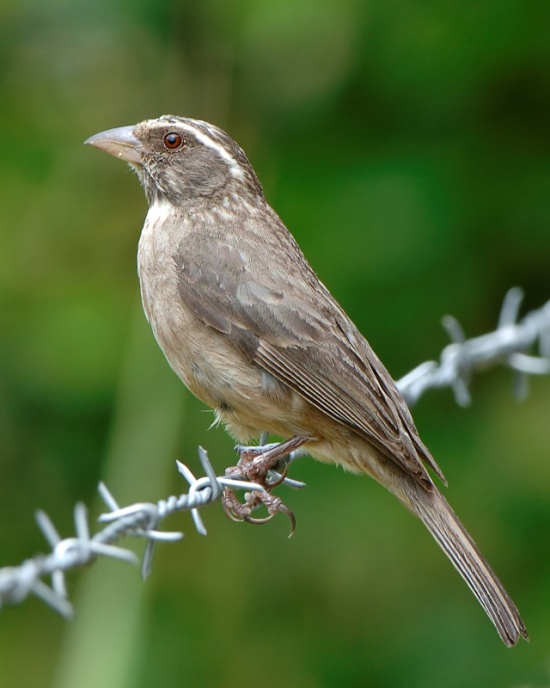m |
m |
||
| (2 intermediate revisions by the same user not shown) | |||
| Line 1: | Line 1: | ||
| − | + | ;[[:Category:Crithagra|Crithagra]] gularis | |
| − | + | ''Serinus gularis'' | |
| − | ;[[:Category: | ||
[[Image:Streaky-headed_Seedeater.jpg|thumb|550px|right|Photo by Mybs]] | [[Image:Streaky-headed_Seedeater.jpg|thumb|550px|right|Photo by Mybs]] | ||
==Identification== | ==Identification== | ||
| Line 8: | Line 7: | ||
[[Africa]] south of the [[Sahara]]. | [[Africa]] south of the [[Sahara]]. | ||
==Taxonomy== | ==Taxonomy== | ||
| − | + | Five subspecies recognized: | |
| − | + | * ''C. g. benguellensis'' in the Highlands of central [[Angola]] to west [[Zambia]] | |
| − | + | * ''C. g. mendosa'' from northeast [[Botswana]] to west [[Zimbabwe]] and adjacent highland [[Mozambique]] | |
| − | + | * ''C. g. gularis'' in southeastern [[Botswana]] and northern [[South Africa]] | |
| + | * ''C. g. endemion'' in eastern [[South Africa]] (Mpumalanga to central Free State and KwaZulu-Natal), [[Lesotho]], [[Swaziland]], and southern [[Mozambique]] | ||
| + | * ''C. g. humilis'' in southern [[South Africa]] (Western Cape and Eastern Cape) | ||
| + | Formerly considerd conspecific with [[West African Seedeater]] (and still so by Clements).<br /> | ||
==Habitat== | ==Habitat== | ||
Open woodland and scrub, including savanna, orchards, and gardens. | Open woodland and scrub, including savanna, orchards, and gardens. | ||
| Line 19: | Line 21: | ||
The diet includes soft fruit, weed seeds and buds, and sometimes insects. Large flocks can damage crops. | The diet includes soft fruit, weed seeds and buds, and sometimes insects. Large flocks can damage crops. | ||
==References== | ==References== | ||
| − | # | + | #{{Ref-Clements6thAug17}}#{{Ref-GillDonsker15V5.3}}#{{Ref-HM04}}# Sinclair I & Ryan P. 2003. ''Birds of Africa south of the Sahara''. Princeton University Press. ISBN 0620207299 |
| − | # | ||
| − | # | ||
| − | # Sinclair I & Ryan P. 2003. ''Birds of Africa south of the Sahara''. Princeton University Press. ISBN 0620207299 | ||
==External Links== | ==External Links== | ||
| − | {{GSearch| | + | {{GSearch|Crithagra+gularis}} |
| − | [[Category:Birds | + | [[Category:Birds]] [[Category:Crithagra]] |
Revision as of 19:31, 28 September 2017
- Crithagra gularis
Serinus gularis
Identification
13-14 cm. Pinkish-brown mantle and back with some faint streaking and a plain pinkish-brown rump; white-streaked crown, greyish-brown face, nape and neck, and white supercilium and chin; buff underparts, buffy grey on the breast. The sexes are similar, but some females show a little breast streaking. The juvenile has less head streaking, a dull supercilium, more heavily streaked upperparts, and heavy streaking on the pale grey underparts.
Distribution
Taxonomy
Five subspecies recognized:
- C. g. benguellensis in the Highlands of central Angola to west Zambia
- C. g. mendosa from northeast Botswana to west Zimbabwe and adjacent highland Mozambique
- C. g. gularis in southeastern Botswana and northern South Africa
- C. g. endemion in eastern South Africa (Mpumalanga to central Free State and KwaZulu-Natal), Lesotho, Swaziland, and southern Mozambique
- C. g. humilis in southern South Africa (Western Cape and Eastern Cape)
Formerly considerd conspecific with West African Seedeater (and still so by Clements).
Habitat
Open woodland and scrub, including savanna, orchards, and gardens.
Behaviour
It builds a compact cup nest in scrub.
The diet includes soft fruit, weed seeds and buds, and sometimes insects. Large flocks can damage crops.
References
- Clements, J. F., T. S. Schulenberg, M. J. Iliff, D. Roberson, T. A. Fredericks, B. L. Sullivan, and C. L. Wood. 2017. The eBird/Clements checklist of birds of the world: v2017, with updates to August 2017. Downloaded from http://www.birds.cornell.edu/clementschecklist/download/
- Gill, F and D Donsker (Eds). 2015. IOC World Bird Names (version 5.3). Available at http://www.worldbirdnames.org/.
- Dickinson, EC, ed. 2014. The Howard and Moore Complete Checklist of the Birds of the World. 4th ed. Princeton: Princeton Univ. Press. ISBN 978-0956861122
- Sinclair I & Ryan P. 2003. Birds of Africa south of the Sahara. Princeton University Press. ISBN 0620207299




